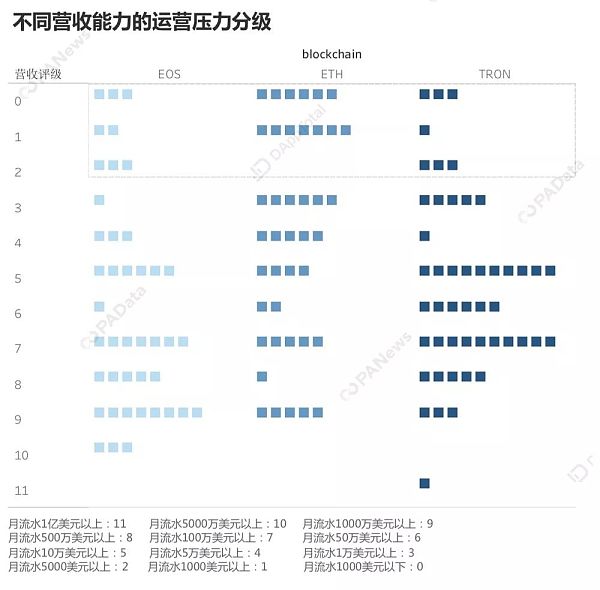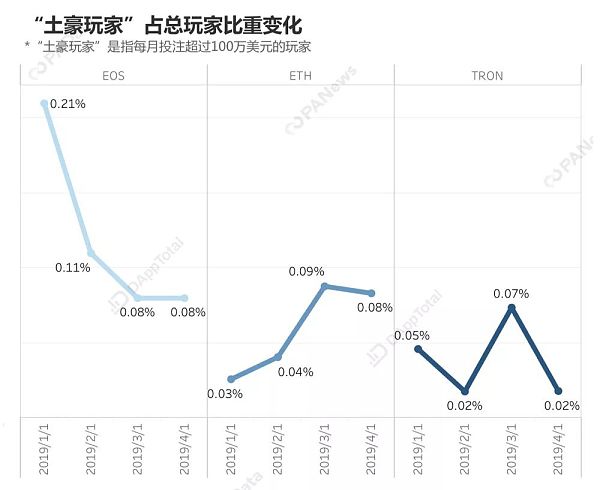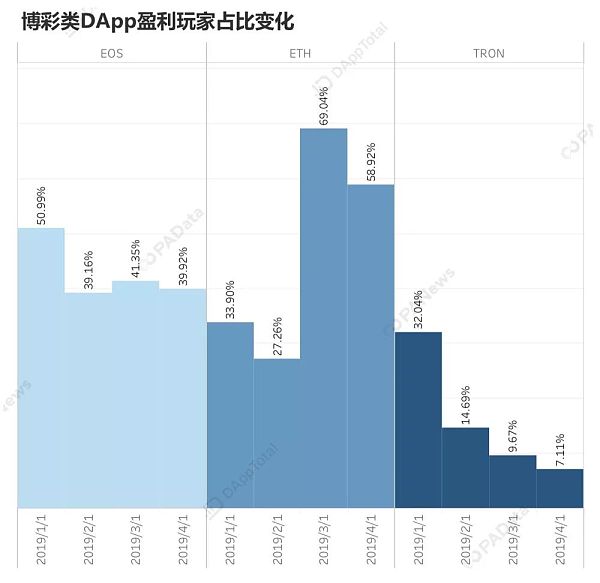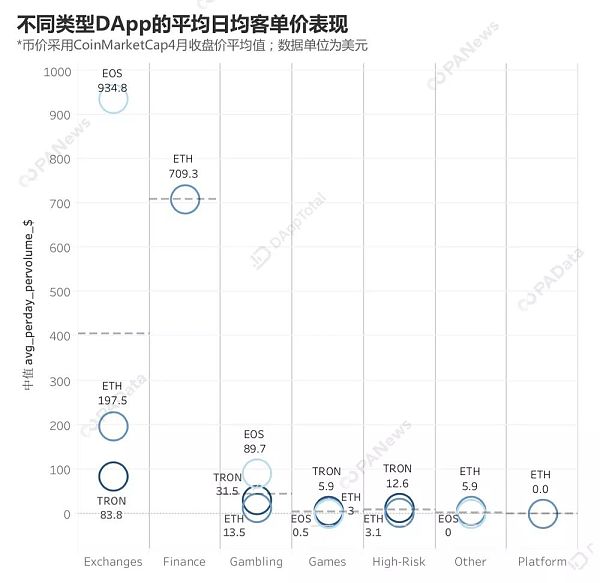DApp's "AARRR" user operation strategy (below)
This article is an excerpt from the report "DApp "AARRR": ETH/EOS/TRON three public chain DApp user portrait study" (below).
The main problem facing the development of DApp today is not unmanned development, but how to operate to make DApp “live” for a long time and “live” better.
As a new thing in the Internet products, DApp will inevitably reflect the thinking of Internet product operation in the formation of its operation mode. The "AARRR" model, the "La New-Activate-Retain-Transfer-Redirect" operating model, has matured in the development of Internet products. The next section will focus on the performance of DApp in the transformation and referral.

- DApp's "AARRR" User Operation Strategy (on)
- The hardest core blockchain game
- IOST legend shocks on the line to achieve the perfect integration of blockchain and traditional online games | DApp Express
PAData Inghts:
1. EOS's gaming class DApp has a total monthly revenue of 269 million US dollars, and 42.85% of monthly gaming users can make a profit. TRON last month averaged 25.94% of gaming users to make a profit, with the lowest proportion of profitable users.
2. About one out of 833 users on EOS is “local player”. One of the approximately 1667 users on ETH has “local player”, and one of the approximately 2,500 users on TRON has “local player”.
3. The class of DApp with the highest average net user value of financial and financial categories on ETH reaches 709.3 US dollars per person per day.

Gaming class is the most profitable
DApp revenue pressure on ETH
The actual meaning of "conversion" is how many users of DApp operators or communities have converted and how much money they have earned. The deeper point behind this is whether DApp has a profit model.

Different types of DApps have different profitability. According to the DApp monthly water estimate of the April average DAU Top 50, the dominant type of gaming DApp is the most profitable on EOS. On ETH, the dominant type of game DApp is also the most profitable. But on TRON, the dominant type of high-risk DApp is not the most profitable category, with a total gross profit of about $15 million, far below the gross profit of the gaming-based DApp of more than $200 million.
If you look at the micro level inside the different types of DApps in different public chains, you can see that the profitability of each DApp within each DApp also shows a significant differentiation phenomenon. The DApps with the heads with strong revenues “beautify” the entire category. The revenue performance of DApp's overall revenue is largely debatable.
For example, the most profitable gambling DApp on EOS, the internal DApp profitability differentiation is obvious. The average daily average of a single DApp is more than 350,000 US dollars, and the median value is only 90,000 US dollars. It can be seen only in the gaming DApp. Individual DApps have superior profitability, and most other gaming DApps have more profitability. Similarly, the game class DApp on ETH also showed a similar situation.
Monthly flow can measure the pressure on the DApp operations team (including the community). The higher the magnitude, the smaller the operational pressure. Otherwise, the operational pressure is greater and even more difficult.

Assuming that the monthly flow of less than $1,000 (revenue rating of 0) is not sustainable, then there are 12 DApps in the DAU TOP 50 on the three public chains, accounting for 8%. Assuming that the monthly flow of water is above $1,000 and below $5,000 (with a revenue rating of 1), it is very difficult to operate. Then there are 10 DApps in the DAU TOP 50 on the three public chains, accounting for 6.67%. Assuming that the monthly flow of water is more than 5,000 US dollars, less than 10,000 US dollars (revenue rating of 2) is barely maintained, then there are 6 DApps in the DAU TOP 50 on the three public chains, accounting for 4%. There are 28 of these three categories, accounting for about 19%, of which ETH accounts for 13. From this perspective, the profit pressure of DApp on ETH is relatively larger.

EOS "local user" most
TRON's "chives" are mostly harvested
“Local Casino Players” means users who have bet more than $1 million per month in the Gaming DApp. The EOS gambling DApp has the largest number of “local players”. The highest proportion in the first four months of this year reached 0.21%, with an average of 0.120%, which is equivalent to one of the average 833 users “local tyrants” . However, these "local players" on EOS have a tendency to lose, and the proportion of "local players" has a downward trend.
The local players on ETH and TRON are much less than EOS. ETH has an average of 16.5 “local players” in the first 4 months of this year, with an average of 0.059%, which is equivalent to 1 “1 local user”. . In the first four months of this year, TRON has an average of 52.3 “local players” per month, with an average of 0.039%, which is equivalent to one of the 2,500 users who are “local players” .

In addition to the proportion of “local customers”, the proportion of profitable users of gaming users is also an important reference indicator for measuring the user's ecology. If the proportion of profitable people is more than 50%, the “banker-player” relationship is more unbalanced. The ecology is about unhealthy.
Taking the first four months of this year as the observation window, we can see that the average 42.85% of the gambling DApps on EOS can be profitable. It is the most balanced relationship between the “banker-player” relationship in the three popular gambling DApps. The proportion of profitable users of GT on the gambling DApp has jumped from about 30% in the previous two months to about 63% in the past two months. Although there are more players making money, the relationship between “banker-player” is always at Unbalanced state. The proportion of profitable users of TRON's gaming-based DApp continued to fall, from 32.04% in January to 7.11% in April, with an average monthly decline of 25.94%. The relationship between “banker-player” is not always in an unbalanced state, and it is accelerating imbalance. status. This means that the possibility that the gaming DApp on TRON may face bankruptcy due to the lack of continuous inflows is increasing.


Leading class DApp users have lower net worth
The exchange has the highest average user net worth
Although there are “local players” in the gambling DApp, the net value of the gambling DApp (user's single transaction amount) is not high. The average user net worth for EOS betting is only $89.7, TRON is only $31.5, and ETH is as low as $13.5.
It is worth noting that on the EOS and TRON, the exchanges are the average (median) average daily average customer price unit of the same type of DApp, reaching a per capita daily transaction amount of 934.8 US dollars and 83.8 US dollars. And from the revenue rating, no exchange is in the operating pressure zone of 0-2.
In addition, the net value of users of the gambling, games and high-risk DApps, which are dominant in the three public chains, are not high. If these three types of DApps want to get more users to maintain or improve their operational status, they will face more intense competition in the new and activated links.

On the other hand, user net worth can also be used as a red line to measure DApp's operating costs. If the average customer cost is higher than the average user net worth, DApp's capital chain will face greater pressure. From this perspective, financial and financial exchanges and exchanges are the two types of DApps that can best withstand the pressure of operating costs, or can be understood as the two most powerful types of DApps that are “burning money”.

Social network efficiency has not yet formed
From the available public information, some DApps use the “referral” marketing approach. For example, some exchanges or games have been invited to reward bonus activities in the early days. Old users invite new users to register to receive certain token rewards.
However, the current "referral" method used by most DApps is profit-driven, and its essence is that compound interest makes both parties involved in the fission mutually beneficial. This has spawned new problems, such as increased direct costs and reduced profit margins. The bigger problem is that cashback is easy to attract some non-precise users who only come back for cash. This is also an important incentive for brushing.
In addition, there are already mature methods in the "referral" operation of Internet products, such as community fission, punch card sharing, resurrection, test sharing, challenge sharing, inventory sharing, grouping, distribution, unlocking. , bargaining, equity sharing, group welfare… have not yet appeared on a large scale in the operation of DApp. DApp still has a lot of imagination in the future "referral" operation.
We will continue to update Blocking; if you have any questions or suggestions, please contact us!
Was this article helpful?
93 out of 132 found this helpful
Related articles
- Dapp warms up these 8 Dapp navigation to find out
- Chain Tea Interview: EOS Three Kingdoms: How was the chain tour that opened the first day of trading on the first day of trading?
- How to smash a BCH in a toilet, trash can or a grove? I laughed after reading it.
- Please pay attention to "App Governance". This is the Achilles of DApp.
- DApp evaluation, wilderness, gold mining: a massively multiplayer online real-time economic strategy game
- Blockchain game: irrelevant technology as long as fun
- Ether cat founder Benny: chain life should be more than 100 years






